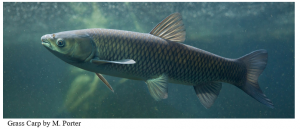Introduced species have been a hot topic in the United States for quite some time regarding their abilities to disrupt native populations and cause environmental and economic harm. These plants and animals are introduced in a variety of ways and are generally the result of ignorance and lack of general knowledge on the subject. Fish, in particular, can be introduced in a variety of ways including; being released as a pet, exotic fish markets, or to control vegetation as is the case for carp. Carp were introduced in the United States in 1963 and are one of the most popular fish in the Midwest as they can be found in most of the Mississippi river basin and are used in lakes and ponds to control vegetation (Sutton, 1997). Efforts have been made to keep these animals out of waterways where they are not wanted like in the case of Lake Erie. Fish biologists and engineers have implemented electrical systems that keep the larger fish like carp from passing through but allow smaller fish to swim through freely. This system and systems like this have been used in many tributaries of Lake Erie trying to keep its waters free of unwanted pests like grass carp. With these systems in place, only a few individuals have ever been found in Lake Erie (Cudmore & Mandrak, 2004).

Sources:Grass carp, Ctenopharyngodon idella, are a larger carp species that can decimate areas from their aggressive eating habits (Leslie Jr et al., 1987). Researchers have recently found grass carp eggs in a Lake Erie tributary putting officials on guard. These carp are especially dangerous in this situation because of the damage they could do to the wetland restoration projects in the area (Miller, 2017). Wetlands are not only important for water quality but are home to many different animal and plant species. The introduction of the grass carp could destroy spawning grounds for some fish species and could have an impact on Lake Erie fisheries. They could also destroy possible nesting habitat for wetland bird species which include hunted birds like ducks and other species that are important to bird watchers which makes stopping the carp from getting to the lake extremely important. The team working on the case is using an electric current to stun the fish and net them. Their plans are to capture the fish before they get to the lake and spawn (Miller, 2017). This effort is why conservation is so important to the waterways in the United States. These efforts to keep grass carp out of Lake Erie are not only to benefit the wetland and its inhabitants but also for the good of the people. Lake Erie is a large diverse system with many connected waterways and wetlands. These are home to many fish, bird, and terrestrial animals that we hunt, watch, and photograph. These efforts to conserve the native fish species and vegetation in Lake Erie are imperative to the future care of our waters. This situation and situations like this are how we begin to become more proactive and protective of what we love dearly. I encourage all readers to be proactive in situations like this one and educate those who may not know about these issues to prevent future issues in our waterways.
- Cudmore, B., & Mandrak, N. E. (2004). Biological synopsis of grass carp (Ctenopharyngodon idella). Canadian manuscript report of fisheries and Aquatic Sciences, 2705(7).
- Sutton, D. L. (1977). Grass carp (Ctenopharyngodon idella Val.) in North America. Aquatic Botany, 3, 157-164.
- Leslie Jr, A. J., Dyke, J. M. V., Hestand III, R. S., & Thompson, B. Z. (1987). Management of aquatic plants in multi-use lakes with grass carp (Ctenopharyngodon idella). Lake and reservoir management, 3(1), 266-276.
- Porter, M. (2007). Controlling Aquatic Vegetation with Grass Carp. Retrieved September 26, 2017, from https://www.noble.org/news/publications/ag-news-and-views/1997/june/controlling-aquatic-vegetation-with-grass-carp/ (Picture)
- Miller E. (2017). Grass carp eggs discovered in Lake Erie tributary. Retrieved September 26, 2017, from https://www.northcountrypublicradio.org/news/story/34656/20170914/grass-carp-eggs-discovered-in-lake-erie-tributary
